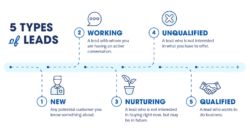Back To Basics: Rethinking Your Strategies
“Lead gen” is something of a buzzword these days — a term we throw around in meetings. But the reality is that marketers often chase numbers and percentages rather than thinking about them as individual customers.
In some ways, that can seem a bit reductionist. Data-driven marketing often deals with lead gen by asking “How do I get more results?”
That’s a good question, of course. But a different way to see that problem is “How can I better understand my ‘ideal customer’?” In other words, focus on the intent of a lead segment rather than the action you want that group to take.
This sort of approach changes how you address lead gen problems; more importantly, it can also make your strategies more efficient over time.

Think of it this way: Your business wants a sustainable funnel of new customers. To achieve that, you’ve spent some time coming up with new lead gen ideas…but you aren’t sure what will work best.
Do you try all of them and see what works? Do you plan to try some split testing? Do you stagger the ideas out and compare long-term results?
Again, those are all good questions that lead to innovation based on hard, factual data. The most successful marketers think about lead gen problems like a scientist, and that starts with ideation and refinement.
In other words, trial and error.
Every scientific test needs to begin with a hypothesis, an idea that you want to either prove or disprove. Since you don’t have any information to make the choice for you, it’s your job to go out there and collect the data somehow. That’s the only way to validate your hypothesis; it’s also how you find out if your lead gen ideas are actually working how you want them to.
How To Integrate Testing Across Your Sales Funnel
Once you come up with your hypothesis and set your sights on a particular test, it’s time to implement that plan. But you don’t want to just drop that into your existing marketing strategy. You want to narrow your focus as much as possible, particularly if your goal is lead gen.
When it comes to integrating split testing, most acquisition experts divvy everything into three categories with different actions that you can take.
This structure functions a lot like the overall buyer’s journey, but it’s zoomed in on a very specific subset of your overall marketing strategy.
- Awareness: Think of this as the social media side of things. You put your content and brand on a variety of different sites (either organically or as paid ads) for a reason. And since you can’t rely on that sort of platform for a great ROI, it means your focus is on engaging your audience and spreading the word about your company.
- Interest: After spreading awareness, your next task is sharing content that makes people want to visit your website to learn more. You’re still looking for a “formal” connection, which might be an inquiry, a newsletter signup, or an email capture.
- Action: Here’s the “Victory Dance” stage of the cycle. The prospect has shown interest in a product or service you offer and now they’re part of your sales cycle.
These are classic pieces of an overall marketing strategy, but a lot of businesses miss out on the benefits of applying the same segmentation to each phase of the sales funnel. (In fact, your lead gen funnel will probably look pretty familiar.)
One of those benefits is — yup, you guessed it — the ability to create more efficient split testing opportunities. The lead gen site CXL breaks it down into parallel charts so you can see the steps from “gain awareness” to “express interest,” and then from “express interest” to “take action.”
Of course, all of that information only gets you so far. You can formulate ideas for how to move someone through the top of your funnel, and you can put some of those strategies into action.
But if you want to see what works — and how to build a better, more efficient funnel — you have to invest in A/B testing.
Remember that illustration of approaching your lead gen ideas like a scientist? Well, split testing is the best way to put your ideas (and their results) under the microscope.
Here is an A/B testing framework recommended by Optimizely:
- Collect data
- Identify goal
- Make hypothesis
- Create variation
- Run experiment
- Analyze result
You can see a clear throughline here, and it should match up with the way you approach other challenges in your overall marketing strategy. The first step is always to check what you’ve got right now, using the data to paint the picture of how things are. That’s the only way to take the next step, which is choosing how you wish things were and what needs to change to get there.
Then comes the fun part: developing a hypothesis. It’s important to think of the hypothesis as a fact you are trying to prove by collecting data. And by assuming your hypothesis is correct, you can begin to make variations of the element you are testing. (“I think a red background will increase email clickthrough” should lead to testing different background colors in your template.)
Once that’s squared away, you get to run your experiment and start collecting results. That’s the kind of data that will either support or refute your hypothesis, and then you can start the process over again as many times as it takes.
Like a scientist, you can run as many experiments and test as many hypotheses as you need to. Your goal is to form better lead gen ideas, test them, and use the data to keep improving.
Because lead gen — like the buyer’s journey — is a closed loop where each new version is clearer, cheaper, and more effective than its parent. And at the end of the day, that practice will evolve into a powerful and reusable tool that keeps your lead gen ideation running smoothly.
Want to help contribute to future articles? Have data-backed and tactical advice to share? I’d love to hear from you!
We have over 60,000 monthly readers that would love to see it! Contact us and let's discuss your ideas!
